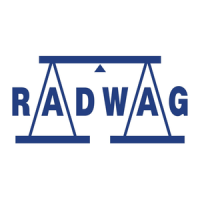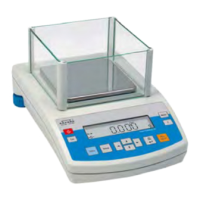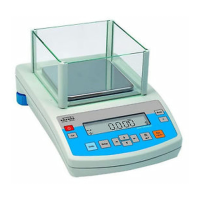
Do you have a question about the RADWAG PS 6000.R2 and is the answer not in the manual?
Details the technical specifications for the XA series balances.
Details the technical specifications for the AS series balances.
Lists technical specifications for PS series balances with a 128x128mm weighing pan.
Lists technical specifications for PS series balances with a 195x195mm weighing pan.
Details the technical specifications for the APP series balances.
Details the available ports for balance connectivity (RS232, USB, WiFi).
Describes the specific features and capabilities of the PS R2.H series balances.
Explains the primary purpose and intended application of the weighing instrument.
Lists prohibited uses to prevent damage, malfunction, or safety hazards.
Outlines conditions under which the balance warranty becomes invalid.
Guidelines for maintaining the instrument's measurement accuracy over time.
Advises users to read the manual thoroughly, even if experienced.
Emphasizes the necessity of trained personnel for operation and maintenance.
Instructions for checking the package and device for damage upon delivery.
Guidelines for retaining and using original packaging for safe transport.
Advice on environmental conditions, stability, and placement for setup.
Step-by-step guide for unboxing, removing protective elements, and initial assembly.
Procedure for ensuring the balance is level for accurate measurements.
Instructions for safely cleaning the balance and its components.
Guidance on connecting the balance to the power supply.
Instructions for connecting external devices like printers and computers.
Lists and describes the various weighing units supported by the balance.
Overview of the different operational modes available on the balance.
Settings to configure balance operation based on environmental factors.
Settings for managing serial, USB, and Wi-Fi communication.
Precautions and procedures before connecting peripherals.
Explains the importance of thermal stabilization before measurement.
Describes how to navigate and select options within the balance's menu system.
Overview of the balance adjustment and calibration functions.
Lists and describes the various operational modes available.
Details configuration options for balance communication ports.
Settings for connected peripherals like printers and computers.
Configuration parameters for customizing printout content.
Configuration of general parameters like language, date, and time.
Displays informative data about the balance and its software.
Steps for initial user login, password entry, and configuration.
Instructions on how to properly log out of the balance session.
Details the permissions associated with USER, ADVANCED, and ADMIN access levels.
Essential steps for accurate and safe weighing operations.
Procedure for setting the balance indication to zero.
How to subtract the weight of a container or packaging.
Configuration options specific to the weighing mode.
Adjusts response speed vs. stability for weighing results.
Sets how measurement results are confirmed (e.g., FAST, RELIABLE).
Enables automatic correction of the zero indication.
Allows showing the last digit for enhanced precision readings.
Configures balance operation for stable or unstable environments.
Allows automatic taring of packaging during weighing.
Configures how and when measurement data is printed.
Allows changing units during a weighing session.
Sets the default weighing unit upon balance power-on.
User selection of which weighing units are available for temporary use.
Enables defining custom weighing units based on factors.
Function to display additional information on the balance's bottom line.
Allows users to input and display custom text on the balance.
Enables assigning functions to F1-F4 keys for quick access.
Details on how to use the balance's dual weighing ranges.
Selection of the language for the balance's menu interface.
Setting user access privileges for menu options.
Enabling or disabling audible feedback for button presses.
Control over the display's backlight intensity and on/off state.
Setting the current date and configuring its display format.
Setting the current time and configuring its display format.
Performing automated performance checks and diagnostics.
Details on performing internal balance adjustments automatically or manually.
Accessing various calibration and adjustment settings via the menu.
Starts the internal adjustment process automatically without user intervention.
Guides the user through calibration using external weights.
Allows for user-defined calibration with external weights.
Verifies the accuracy of the internal adjustment against saved parameters.
Configures automatic adjustment triggered by temperature changes.
Sets time intervals that trigger automatic balance adjustments.
Procedures for performing manual balance adjustments.
Steps for manually performing internal balance adjustments.
Steps for manual calibration using external weights.
Steps for manual calibration using user-defined masses.
Instructions on generating and printing balance adjustment reports.
Configures which data fields are included in adjustment reports.
Defines the information to be included in the header of printouts.
Configures the content of measurement result printouts following GLP standards.
Defines the information to be included in the footer of printouts.
Allows customization of printout formats with text and variables.
Guides on using variables and text in custom printout designs.
Explains how to define and use alphanumeric variables in printouts.
Managing user accounts, passwords, and access levels.
Details on USER, ADVANCED, and ADMIN permissions.
Adding and managing product information for weighing.
Storing and managing tare values for containers.
Automatic saving and retrieval of weighing data.
Utilizing the Alibi memory for secure measurement storage.
Procedures for backing up balance data to external memory.
Procedures for restoring balance data from external memory.
Instructions for saving measurement data onto external storage.
Customizing which working modes are accessible to the user.
Functionality for counting small items based on sample weight.
Configuration options specific to the piece counting mode.
Automatic determination of sample mass from a known quantity.
Manual input of the known sample mass for calculations.
Exiting the current working mode and returning to the main weighing screen.
Mode for verifying item weight against defined low and high thresholds.
Setting the low and high limits for checkweighing operations.
Mode for dispensing materials to a specific target weight with tolerance.
Defining the target mass and tolerance for the dosing process.
Calculating percentage deviation of samples from a reference mass.
Using the balance to measure and set the reference mass for deviation checks.
Manually entering the reference mass for deviation checks.
Mode for accurately weighing objects in motion.
Procedure for manually initiating the animal weighing process.
Procedure for automatically initiating the animal weighing process.
Using a kit to determine the density of solid materials.
Detailed steps for measuring the density of solid substances.
Using a kit to determine the density of liquid materials.
Collecting and analyzing measurement data to generate statistics.
Steps for performing statistical analysis on measurement series.
Procedure for clearing statistical data from the balance.
Summing up the weights of multiple ingredients in a mixture.
Capturing and displaying the maximum weight reading during a weighing.
Process for calibrating pipettes using the balance.
Customizing parameters for pipette calibration procedures.
Step-by-step guide for performing pipette calibration.
Configuring serial communication parameters like baud rate and parity.
Setting up the balance for wireless network connection.
Procedures for establishing communication between the balance and a computer.
Selecting the correct port (COM, USB, WiFi) for computer connectivity.
Enabling or disabling real-time data transfer from the balance.
Integrating the balance with the E2R control system.
Connecting and configuring a printer for balance output.
Connecting and configuring a barcode scanner for data input.
Connecting and configuring an external display unit.
Connecting and configuring external buttons for TARE and PRINT functions.
Wiring details for connecting computers and printers to the balance.
Configuring the format of data sent from the balance to external devices.
Structure of data sent when the PRINT button is pressed.
A list of commands for controlling the balance remotely via RS232.
Explains the format of responses the balance sends to commands.
Detailed explanations for specific commands like Zero and Tare.
Equipment designed to reduce vibrations for stable positioning.
Accessory specifically for under hook weighing operations.
Kit used for determining the density of solid and liquid materials.
Features and specifications of the external balance display.











